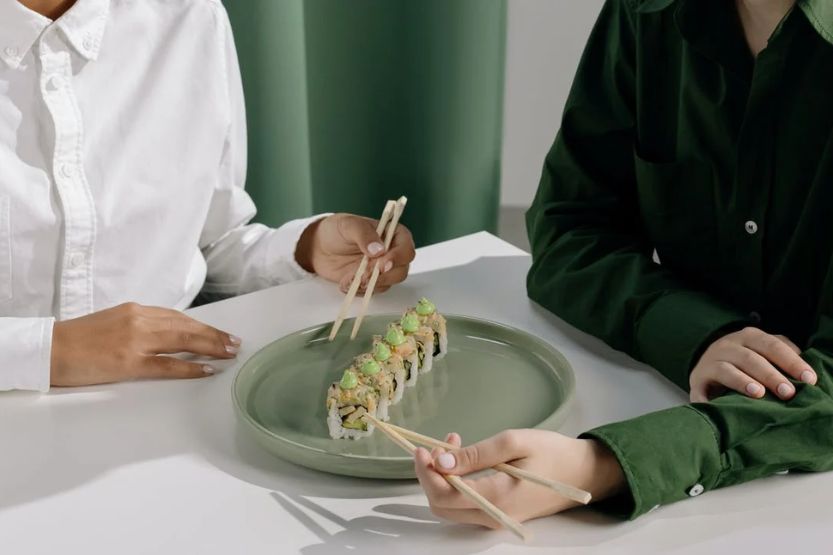If you’re a sushi lover, you’ve probably tried wasabi, the green paste that comes alongside your favorite rolls. But if you’ve ever wondered what real wasabi tastes like, what exactly is in wasabi, or how it’s made, you’re in luck!
Real wasabi is pungent and has a nasal-clearing effect that begins immediately after tasting it. Fresh, authentic wasabi is spicy but not that hot. It has been associated with fresh, fatty, sweet, fragrant, and pickle-like flavors and odors.
Read on to learn more about the unique flavor profile of wasabi, how to tell real wasabi from fake stuff, and how to make it at home.
Is Real Wasabi Spicy?

Wasabi has a strong flavor described as spicy, pungent, hot, and nasal-clearing. It is most commonly used in sushi but can also add flavor to other dishes, such as soup or stir-fry.
Another name for wasabi is Japanese horseradish. It comes from the root of a plant in the brassica family, which also includes horseradish, mustard, and broccoli. The root is grated or ground into a paste used as a dish condiment or ingredient.
What Does Wasabi Taste Like?
Some say that wasabi has a bitter aftertaste, and others describe it as having an almost sweet flavor. Wasabi is commonly confused with horseradish because the two have a similar flavor profile. However, they do not have the same flavor notes.
Horseradish Has a Stronger Flavor Than Wasabi
Horseradish has a stronger, more pungent flavor than wasabi. The two spices are sometimes combined to create a unique blend of flavors.
Knowing this matters because wasabi is a common flavor in sushi and other Japanese dishes. It’s important to know the difference between wasabi and horseradish so that you can properly identify the flavors in your dish.
What Should You Use When Making Sushi?
You would not want to use horseradish to replace wasabi when making sushi because it would change the dish’s taste:
- If you are looking for a strong, pungent flavor, then wasabi is the better option; and
- If you are looking for something with a bit more sweetness, horseradish may be a better choice.
Real vs. Fake Wasabi
When you think about sushi, wasabi is probably the first thing that comes to mind. It’s that spicy green paste that you mix into your soy sauce and spread over your sushi roll, or sometimes even eat on its own. But did you know that most of the wasabi served at American sushi restaurants is fake?
1. Real Wasabi Contains Wasabi Root
You might be thinking, “Fake wasabi? That can’t be true!” But it is, and here’s why. The real deal is hard to come by in the United States because it takes a lot of time and effort to grow and prepare.
And since wasabi grows best in cold temperatures, it takes a lot of time and effort to grow and prepare outside Japan. The result is a very expensive product that most American consumers don’t have access to.
Wasabi plants are notoriously tough to grow and need precise conditions. Wild wasabi plants grow naturally along river banks in mountain river valleys across Japan.
This optimal growing environment is incredibly rare, with the stems of wasabi plants partially submerged in running water during cultivation.
Cultivating wasabi plants commercially in Japan’s mountain river basins is difficult without running stream beds, making wasabi a premium plant to grow.
Throughout Japan, the prefectures of Nagano, Iwate, and Shimane are known for their production of wasabi. However, the Izu Peninsula region in Shizuoka Prefecture accounts for around 70% of Japanese wasabi production.
2. Fake Wasabi Contains Horseradish or Mustard Powder
Real wasabi is grown in the ground and must be grated with a special grater to get its signature green color and flavor. It can be used immediately after grating, but it’s also great if you let it sit for a few minutes before serving.
Fake wasabi, on the other hand, contains horseradish or mustard powder dyed green and mixed with food coloring. It’s often sold in powdered form or as a paste that must be mixed with water before serving.
3. Taste
Freshly-grated real wasabi possesses a signature “clean” spiciness that, while mild at first, gradually gives way to a touch of fire in the nostrils before swiftly fading away. Fake wasabi might be zingy, but it lacks the clean taste of authentic wasabi.
Its flavor comes from an enzyme in the plant called myrosinase, which breaks down into allyl isothiocyanate (AITC) when it’s exposed to water. AITC is what gives real wasabi its distinctive taste. It also irritates our nasal passages, which can cause us to cough if we eat too much of it at once.
Fake wasabi is made from horseradish and mustard powder mixed with food coloring. And that’s pretty much it! It doesn’t have any AITC or other enzymes present in real wasabi plants.
So while it looks similar and may taste somewhat similar at first glance, there’s no comparison regarding the true wasabi experience.
So which one should you use? Real wasabi is more expensive than fake wasabi, but real wasabi has so much more flavor, and it’s also better for your health.
Is Wasabi Bad for You?

You may have heard that wasabi is bad for you. But don’t let that stop you from enjoying this delicious condiment! While it’s true that wasabi can cause some unpleasant side effects, they’re rare and easily avoided.
They’re real, but only when consumed in large amounts over time.
Can Cause Eyes to Tear Up
The immediate concern with wasabi is the allyl isothiocyanate (AITC), which can cause your eyes to tear up and feel irritated when consumed in large amounts over time.
So do not eat too much of it at once. You’ll still get all the benefits without dealing with the side effects.
Other Effects of Eating Too Much Wasabi
Other wasabi concerns include:
- Acid reflux – Because of its spicy, pungent flavor, wasabi may cause acid reflux. So those with stomach ulcers, gastritis, heartburn, or digestive disorders, limit or do not eat wasabi at all. It is bad for pregnant women as well.
- Gastritis – Wasabi’s isothiocyanate content might irritate your stomach lining and worsen gastritis symptoms.
- Allergies – Make sure to talk with a doctor if you haven’t eaten wasabi before, as it can trigger dangerous allergic reactions in some people.
- Liver damage – Wasabi contains a liver toxin. In very small quantities, it’s harmless. But if you eat a lot of wasabi, it may cause liver damage.
- Slows down blood clotting – People with hemorrhoids should avoid eating wasabi because the compounds in the plant can slow blood clotting and irritate sensitive blood vessels.
Again, is wasabi spicy? Wasabi is green and spicy, which makes every dish alive due to its flavor.
What Are the Benefits of Eating Wasabi?
Wasabi is low in calories but high in antioxidants and anti-inflammatory properties, making it great for one’s health. It’s an excellent choice for those trying to lose weight or maintain a healthy diet.
Here are some of the wasabi’s promising health benefits:
1. Promotes Fat Loss
In test-tube and animal studies, wasabi leaf extract has been shown to prevent the formation and growth of fat cells. However, human research is lacking in this area.
2. Has Antibacterial Properties
Compounds in wasabi known as isothiocyanates may have antibacterial properties against certain foodborne illnesses, including the bacterium H. pylori.
3. Has Anti-inflammatory and Anti-cancer Properties
Studies have suggested that wasabi may help prevent inflammation, which is the body’s protective response to injury or infection. Chronic inflammation affects many bodily systems and can lead to diseases like diabetes, heart disease, and certain cancers.
Isothiocyanates prevent acrylamide production. As a result, the compound inhibits the growth of several types of cancer in test-tube studies. Acrylamide can form in foods like French fries, potato chips, and coffee beans during high-temperature cooking, like grilling and frying.
4. Other Potential Benefits for Bone and Brain Health
Decrease Bone Breakdown
In animal studies, a wasabi compound called p-hydroxycinnamic acid has been suggested to decrease bone breakdown and increase bone formation.
According to researchers, this compound could even help address osteoporosis (a disease that causes brittle and weak bones). But more human research studies are needed to support this claim.
May Help Prevent or Slow Down Neurodegenerative Problems
Isothiocyanates in wasabi may have neuroprotective effects. Studies suggest that isothiocyanates may help prevent or slow down neurodegenerative problems driven by inflammation. One example is Parkinson’s disease.
How to Make Wasabi Paste at Home

Authentic Wasabi Paste
Ingredients
To make wasabi paste at home, you will need a few simple ingredients:
- 1 cup grated fresh wasabi root
- Two tablespoons water
- One teaspoon of soy sauce
Instructions
Mix the ingredients in a bowl until it forms a smooth paste. You can store your homemade wasabi paste in the fridge for up to two weeks.
Homemade Wasabi Using Wasabi Powder
Since fresh wasabi root is hard to come by, you can opt for wasabi powder instead. Wasabi pastes are readily available as tubes in Asian grocery shops and most supermarkets.
However, these wasabi tubes contain too much paste than what you need for one meal. After one-time use, a crust forms in the tube, making the paste less desirable and tasty to consume. But I solved this problem by using a small can of S&B wasabi powder.
Instructions
Here’s how to make wasabi paste using wasabi powder:
- Combine 3 tsp of wasabi powder in a small bowl with 1 tsp water.
- Turn the bowl upside down for 1 minute before serving.
Depending on your needs, you can make as much or as little as you want. How easy is that?
Overall, making wasabi paste at home is not difficult. However, it requires a few special ingredients you might not have on hand. With a little planning, you can easily make your own delicious and healthy wasabi paste in your kitchen.
Frequently Asked Questions – Wasabi: Is It Spicy?
How Spicy Is Actual Wasabi?
Wasabi isn’t spicy. It’s like a spicy aroma without the pungent hint of mustard seed flour in the fake stuff. Fake wasabi has an extremely strong flavor that overpowers the delicate fish taste. Its spiciness comes from mustard seed flour.
Is Wasabi Bitter or Spicy?
A wasabi root’s bitterness rather than spiciness might surprise you if you were to eat it. A lot of heat is generated during the grating process. When grated, wasabi cells produce hot vapors, and the grated wasabi remains hot for about 5 minutes.
Is Wasabi Hotter Than Jalapeno?
No, wasabi falls below the jalapeno pepper on the Scoville scale: jalapenos usually come in between 2,500 and 8,000 Scoville heat units (SHU), while wasabi is only comparable to 1,000 SHU.
Of course, you’ll only be able to tell if your wasabi is real by trying an order of sushi made with it. If you think the green paste at your favorite spot has some kick, try requesting real Japanese horseradish and see how that compares.
Why Is Wasabi Hot?
Due to allyl isothiocyanate, wasabi’s spiciness is distinct from hot peppers. Capsaicin, an oil-based chemical that stimulates the tongue, is found in hot peppers. Dairy products, rich in oils and fats, are the only method to eliminate this spiciness.
Is Eating Wasabi Good for You?
There is a significant amount of beta-carotene in wasabi, including glucosinolates and isothiocyanates. According to recent studies, these compounds may have anti-inflammatory, antibacterial, and anti-cancer properties.
Why Is Wasabi Served with Sushi?
Wasabi has long been used to enhance the flavor of fish and to fight bacteria that can be found in raw fish. It’s for this reason that wasabi is still used today. Its flavor is intended to enhance rather than mask the flavor of raw fish.
Conclusion – Is Wasabi Hot?
Wasabi is the green-looking paste that accompanies Japanese dishes like sushi, sashimi, and soba. It is an iconic condiment that adds the right punch of spiciness to bland recipes.
To be specific, authentic wasabi is spicy but not that hot. It also has a nasal-clearing effect after tasting.
Now you know what wasabi tastes like; next time you’re at the sushi restaurant, you’ll have enough courage to ask what you want: real wasabi!
Read next:

![Read more about the article How Long to Boil Chicken Breast? [Boneless, Bone-In, and Frozen]](https://howchimp.com/wp-content/uploads/2020/10/how-long-to-boil-chicken-breast-300x200.jpg)

